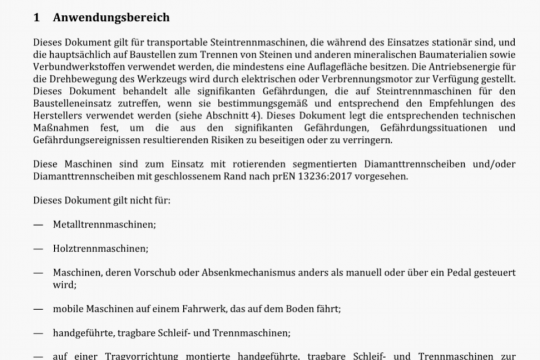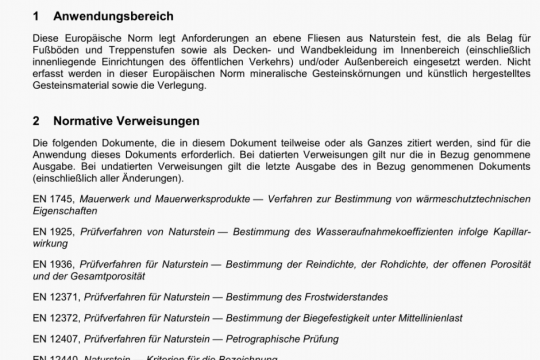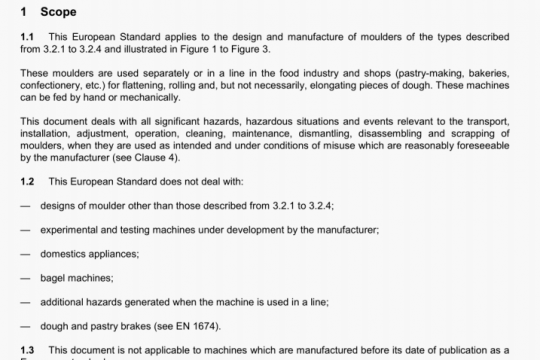DIN EN ISO 844 pdf free download
DIN EN ISO 844-2015 pdf free download.Rigid cellular plastics – Determination of compression properties (ISO 844:2014); English version EN ISO 844:2014, English translation of DIN EN ISo 844:2014-11.
6.2 Devices for measuring displacement and force
6.2.1 Measurement of displacement
Procedure A — The compression-testing machine shall be fitted with a system allowing continuous measurement of the displacement x of the movable plate with an accuracy of ± 5 % or ± 0.1 mm if this latter value is a more accurate measurement (see second paragraph in 6.2.2).
Procedure B — The measure of displacement shall be obtained by attaching an extensometer to the sample or by using similar devices that measure directly the sample deformation, with an accuracy of± 1 %.
6.2.2 Measurement of force
A force sensor shall be fixed to one of the machine plates in order to measure the force F produced by the reaction of the test specimen upon the plates during the test. This sensor shall be such that its own deformation during the course of the measurement operation is negligible compared with that being measured and, in addition, it shall allow the continuous measurement of the force at any point in time with an accuracy of ± 1 %.
ltis recommended that a device be used for the simultaneous recording of the force Fand the displacement x that allows, by obtaining a curve of F = 1(x), the graphical determination of the pair of values F, x required in Clause 9 with the accuracy laid down in 6.2.1 and this subclause. and provides additional information on the behaviour of the product.
6.2.3 Calibration
Devices for measuring and, if applicable. recording graphically the force and displacement produced by the test machine shall he checked periodically. The devices shall he checked by using a series of standard weights, the masses of which are known to accuracies better than ± I % and which correspond to the forces applied during the test. To check the devices, spacers shall be used which have thicknesses known to accuracies better than either ± 0,5 % or ± 0,1 mm, whichever is more restrictive.
6.3 Instruments for measuring the dimensions of the test specimens These instruments shall be in accordance with ISO 1923.
7 Test specinlens
7.1 Dimensions
The test specimens shall be (50 ± 1) mm in thickness except for products with moulded skins which are intended to remain integral with the product in use. With such products, the specimens shall be the full thickness, provided that the minimum thickness Is 10 mm or greater and that the maximum thickness Is not greater than the width or diameter ofhe specimen.
The test specimen base shall be either square or circular, with a minimum area of 25 cm2 and maximum of 230 cm2. The preferred geometry and dimensions are a right prism with a base of (100 ± 1) mm x (100 ± 1) mm.
The distance between two faces shall not vary by more than 1 % (tolerance on parallelism).
Under no circumstances may several test specimens be piled up to produce a greater thickness for testing.
Since sample geometry and dimensions may have an influence on results, it is recommended to compare results only if obtained by testing samples having the same geometry and dimensions.
7.2 Preparation
Test specimens shall be cut so that the specimen base Is normal to the direction of compression of the product in its intended use. In some cases with anisotropic materials where a more complete characterization is desired or where the principal direction of anisotropy is unknown, it may be necessary to prepare additional sets of specimens.
Cutting of the test specimens shall be accomplished by methods that do not change the structure of the cellular material. Moulding skins that do not remain with the product in usc shall be removed.
In general, any anisotropy is characterized by a plane and the direction perpendicular to this plane; thus, two sets of test specimens need to be considered.
7.3 Number
Regarding the method of selecting the samples for preparation of the test specimens from the blocks or slabs of rigid cellular products and also the number of test specimens to be provided for the test, refer to the specification relating to the type of cellular product under test. In the absence of such specifications, use at least five test specimens.
7.4 ConditionIng
Condition the test specimens at:
(23 ± 2) °C and (50 ± 10) % relative humidity
or
(23 ± 5) °C and 50 % relative humidity
or
(27 ± 5) °C and 65 % relative humidity fora minimum of 6 h.
8 Procedure
The test conditions shall he those used for conditioning the test specimens.
Measure the three dimensions of each test specimen in accordance with Iso 1923. Place a test specimen centrally between the two parallel plates of the compression-testing machine and compress it at a rate as close as possible to 10 % of its original thickness per minute. Compress the specimen until Cm or/and CIo are determined
NOTE Using Procedure H. strain is calculated on extensometer gauge length. For contact extensometers, a gauge length of 25 mm has been found satisfactory, on samples having 50mm thickness.
If the compressive modulus of elasticity Is to be determined, record a force.dlsplacement curve and find the most linear steepest part of the curve (see 9A).
Repeat for each of the remaining specimens.DIN EN ISO 844 pdf download.




